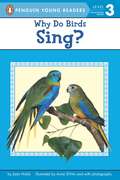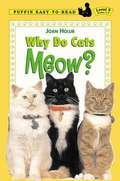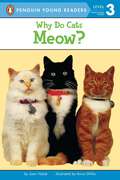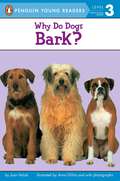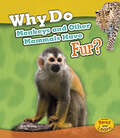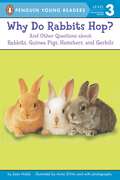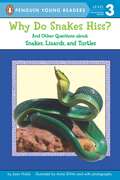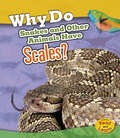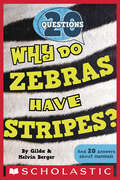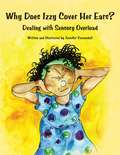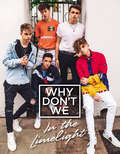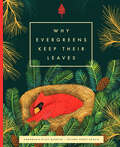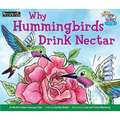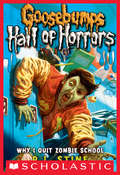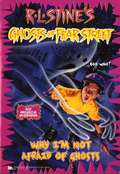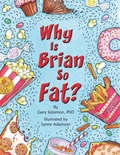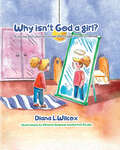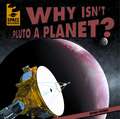- Table View
- List View
Why Do Birds Sing? (Penguin Young Readers, Level 3)
by Joan HolubDo you love birds? If you do, you're not alone! Birds are fun to watch and they make great pets. There is so much to know about birds. Why do they have feathers? Can parrots really talk? Why do birds build nests? Do birds like toys? Beginning readers will find the answers to these questions—and many more—in this lively, fact-filled book. Filled with colorful illustrations and photographs of wild and domestic birds, this is a perfect selection for any young bird-watcher or bird lover.
Why Do Cats Meow? (Easy-to-Read)
by Joan HolubDo you love cats? If you do, you're not alone! Cats are the most popular pet in the United States. There is so much to know about cats. Why do they meow, hiss and purr? Why do they have whiskers, tails and claws? Can they really see in the dark? You'll find out the answers to these questions and many more in this fun, fact-filled book.
Why Do Cats Meow? (Penguin Young Readers, Level 3)
by Joan HolubMany children love cats, and there is so much to know about America's most popular pet. Why do they meow, hiss, and purr? Why do they have whiskers, tails, and claws? Beginning readers can find out the answers to those questions and many more in this fun, fact-packed book filled with colorful feline photos and drawings.
Why Do Dogs Bark?
by Joan HolubDid you know that there's a dog so little, it can fit in your hand? That dogs and wolves are relatives? A dog once kept a snowbound town from getting sick? That dogs, unfortunately, cannot brush their teeth? Dogs are our friends, protectors, and family members. This fact-packed book takes a look at their history, behavior, and characteristics, and offers ways to get to know them a little better. For instance, what does it mean if a dog's tail is up, or its ears are back? How can you get a dog to sit or stay? And, of course, just what is the reason for all that barking?
Why Do Dogs Bark? (Penguin Young Readers, Level 3)
by Joan HolubThere are many different kinds of dogs and so much to find out about them. Why do dogs bark, howl, or bury bones? Why do they like to lick and sniff people? What jobs can dogs do? You'll find the answers to these questions and many more in this fact-filled reader about man's best friend.
Why Do Horses Neigh? (Penguin Young Readers, Level 3)
by Joan HolubDo you love horses? If you do, you're not alone. There's so much to know about these amazing animals. Why do horses neigh? What are baby and adult horses called? How do horses communicate? Beginning readers can find out the answers to these questions-and many more-in this lively, fact-filled introduction to these popular animals. Filled with colorful illustrations and dynamic color photos of real horses, this is a perfect selection for any young horse lover.Illustrated by Anna DiVito.
Why Do I Feel So Worried?: A Kid's Guide to Coping with Big Emotions—Follow the Arrows from Anxiety to Calm
by Tammi KirknessSimple yes-or-no questions help kids ages 7 to 12 find the right calming activities for every kind of anxiety It can be tough for kids with growing minds to work through their worries and self-soothe when they&’re spiraling. This interactive, step-by-step guide is here to help! In Why Do I Feel So Worried?, children can follow an easy-to-use, colorfully illustrated flowchart to . . . Name the emotion they&’re struggling with (like stress)Figure out its source (for instance, homework problems)Calm down with an easy activity (such as a soothing script) Every tried-and-tested strategy—from breathing techniques to meditations, affirmations, and more—offers in-the-moment relief to anxious children. And throughout, notes to caregivers explain the underlying psychology along with how (and when) to offer help. Kids might not always be able to solve what&’s worrying them—but they do have the power to help themselves feel better!
Why Do Leaves Change Color? (Let's-Read-and-Find-Out Science 2)
by Betsy MaestroRead and find out about the magical process of how leaves change their color in this colorfully illustrated nonfiction picture book.This book includes simple, fun diagrams that help introduce concepts like photosynthesis and the different types of leaves. This book also includes a list of the best spots to view leaves changing color as well as simple activities to do with leaves, like leaf rubbings and leaf pressings.Questions addressed in this book include:How do leaves feed trees?What kind of weather brings out the best colors?Why is winter a time of rest for trees?Read and find out in the proven winner Why Do Leaves Change Color?This is a Level 2 Let's-Read-and-Find-Out, which means the book explores more challenging concepts for children in the primary grades. The 100+ titles in this leading nonfiction series are:hands-on and visualacclaimed and trustedgreat for classroomsTop 10 reasons to love LRFOs:Entertain and educate at the same timeHave appealing, child-centered topicsDevelopmentally appropriate for emerging readersFocused; answering questions instead of using survey approachEmploy engaging picture book quality illustrationsUse simple charts and graphics to improve visual literacy skillsFeature hands-on activities to engage young scientistsMeet national science education standardsWritten/illustrated by award-winning authors/illustrators & vetted by an expert in the fieldOver 130 titles in print, meeting a wide range of kids' scientific interestsBooks in this series support the Common Core Learning Standards, Next Generation Science Standards, and the Science, Technology, Engineering, and Math (STEM) standards. Let's-Read-and-Find-Out is the winner of the American Association for the Advancement of Science/Subaru Science Books & Films Prize for Outstanding Science Series.
Why Do Monkeys and Other Mammals Have Fur? (Animal Body Coverings Ser.)
by Holly BeaumontFind out all about fur and how it helps monkeys keep warm and survive. Discover how fur can be used as camouflage, how fur is different on different mammals and how fur changes as mammals grow up.
Why Do Rabbits Hop?: And Other Questions About Rabbits, Guinea Pigs, Hamsters, And Gerbils (Penguin Young Readers, Level 3)
by Joan HolubWhy Do Rabbits Hop?And Other Questions about Rabbits, Guinea Pigs, Hamsters, and GerbilsDid you know that rabbits can jump 10 feet in one hop, guinea pigs bump noses to say hello, and baby gerbils are called pups?
Why Do Snakes Hiss?: And Other Questions About Snakes, Lizards, and Turtles (Penguin Young Readers, Level 3)
by Joan HolubMany people like snakes, lizards, and turtles, and there's so much to find out about all of these scaly-skinned animals. Are all snakes poisonous? Why do snakes shed their skin? What unusual things can lizards do? Do lizards ever lose their tails? Why do turtles have shells? Kids will find the answers—and much more—in this fun, fact-filled introduction to reptiles. Filled with colorful photographs and illustrations, this is just right for any reptile lover.
Why Do Snakes and Other Animals Have Scales? (Animal Body Coverings Ser.)
by Clare LewisFind out all about scales and how they help snakes and other animals move, stay safe and survive. Discover how scales are different on different animals and how they change as snakes and reptiles grow up.
Why Do Zebras Have Stripes? (20 Questions Ser. #2)
by Melvin Berger Gilda BergerThe follow-up to the fun and informative 20 Questions #1: Why Do Feet Smell?A follow-up to 20 Questions: Why Do Feet Smell? (Spring 2012) featuring fun facts about animals. Why Do Zebras Have Stripes? will ask and answer the questions about animals that kids are really curious about. Each book in the 20 questions series contains 20 questions and answers, with a full-color photograph on every page. Read the question on the right and turn the page to see the answer on the left!
Why Does Izzy Cover Her Ears? Dealing With Sensory Overload
by Jennifer VeenendallAn illustrated book that creates an environment that is accepting of students with sensory modulation difficulties, including many on the autism spectrum. It includes definitions of sensory processing and sensory modulation disorder, suggested discussion questions, and lists of related books and websites.
Why Don't We: In the Limelight
by Why Don'T WeIn the Limelight is the official Why Don’t We autobiography, full of never-before-seen photos and behind-the-scenes info about one of today’s hottest bands.When five guys decided to form a band, they never imagined that they would go from playing music online to playing tours across the world so quickly. Why Don’t We has been together for less than two years, and they’ve already headlined sold out shows, played at Madison Square Garden, and amassed millions of fans. And this is all just the beginning.This is the official Why Don’t We story, full of never-before-seen photos and everything you need to know about Corbyn, Daniel, Zach, Jonah, and Jack. Find out the secrets they’ve never shared with fans before, their embarrassing childhood stories, what they look for in a girlfriend, and how it felt to have their lives completely changed by this incredible journey.
Why Don't You Get a Horse, Sam Adams?
by Jean FritzIn the early days of America when men wore ruffles, rode horseback, and obeyed the King, there lived a man in Boston who cared for none of these things. No one expected Samuel Adams to wear ruffles or pledge allegiance to the King of England, but his friends did think that he might get on a horse. But would he? Never! he said. An ALA Notable Children's Book.
Why Evergreens Keep Their Leaves
by Annemarie Riley GuertinIn the spirit of Oscar Wilde's The Happy Prince, Why Evergreens Keep Their Leaves is a timeless story of why the fir, spruce, and juniper trees are evergreen all winter long.
Why Frogs Are Wet
by Judy Hawes Mary Ann FraserFrogs can jump thirty times their own body length, catch insects on the wing, and breathe underwater or on land. But they must always keep their skins wet. Read and find out why!
Why Frogs Are Wet (Let's-Read-and-Find-Out Science 2)
by Judy HawesRead and find out about frogs in this colorfully illustrated nonfiction picture book.Frogs can jump thirty times their own body length, catch insects on the wing, and breathe underwater or on land. But they must always keep their skins wet. Read and find out why! This is a clear and appealing science book for early elementary age kids, both at home and in the classroom. It's a Level 2 Let's-Read-and-Find-Out, which means the book explores more challenging concepts for children in the primary grades. The 100+ titles in this leading nonfiction series are:hands-on and visualacclaimed and trustedgreat for classroomsTop 10 reasons to love LRFOs:Entertain and educate at the same timeHave appealing, child-centered topicsDevelopmentally appropriate for emerging readersFocused; answering questions instead of using survey approachEmploy engaging picture book quality illustrationsUse simple charts and graphics to improve visual literacy skillsFeature hands-on activities to engage young scientistsMeet national science education standardsWritten/illustrated by award-winning authors/illustrators & vetted by an expert in the fieldOver 130 titles in print, meeting a wide range of kids' scientific interestsBooks in this series support the Common Core Learning Standards, Next Generation Science Standards, and the Science, Technology, Engineering, and Math (STEM) standards. Let's-Read-and-Find-Out is the winner of the American Association for the Advancement of Science/Subaru Science Books & Films Prize for Outstanding Science Series.
Why Hummingbirds Drink Nectar: A Hitchiti Indian Pourquoi Tale
by Cynthia Swain Laura Strom Terry Workman Lisa WorkmanLegend has it that Hummingbirds ate fish. In this pourquoi American Indian tale, you'll hear an explanation of why hummingbirds dine only on nectar today.
Why I Quit Zombie School: Hall Of Horrors #4: Why I Quit Zombie School (Goosebumps Hall of Horrors #4)
by R. L. StineWelcome to the Hall of Horrors, HorrorLand's Hall of Fame for the truly terrifying.Poor Matt Krinsky! Not only are his parents making him move away from all of his friends, but they're enrolling him in a boarding school. It's not a strict place, but that doesn't mean things are normal. While Matt is used to be being one of the better athletes in his class, theses kids move a dead-slow pace. It's doesn't take long for him to realize that he's surrounded by zombies. And his classmates have begun to notice his heartbeat and warm skin. Can Matt convince them he is undead long enough to stay alive?
Why I'm Not Afraid of Ghosts (Ghosts of Fear Street #23)
by R. L. StineOliver Brown doesn’t believe in ghosts. Even though he lives in a house on Fear Street that’s chock full of them! Robbie should know—he’s one of the ghosts. And his new neighbor doesn’t scare easy—even though he’s tried everything he can think of to send Oliver screaming. Robbie’s got one trick left up his sleeve. And it has to work. If it doesn’t, he’ll have to give up the ghost business forever.
Why Is Brian So Fat?
by Lynne Adamson Ph.D. Gary SolomonA poignant story of Brian, a twelve-year-old boy who eats instead of feeling to avoid the reality of living with his dysfunctional family.
Why Isn't God a Girl: A Young Girl's Journey to See the Image of God in Herself
by Rev. Diana WilcoxSophy is told that she is made in the image of God, but the only God she has ever heard of is called Father. It doesn't make any sense, so she decides to find out why God isn't a girl. What she discovers changes everything! This beautifully illustrated picture book, by Reverend Diana Wilcox, an Episcopal priest, will captivate the imagination of every child with beautiful illustrations and a narrative that engages both parent and child. Sophy's journey explores themes of gender, interfaith understanding, and diversity in God's creation. The book also includes resources for all who work with and love children. The original edition of Why isn't God a Girl? won a Readers' Favorite Illustration Award winner and a Readers' Favorite Honorable Mention in the Children Religious Theme genre!"Mother Diana's passion for the Gospel and the inclusive message of Jesus has sparked her pastoral response to girls searching for their place in God's plan. Her book helps girls and boys to discover God's feminine image in which women are created. She places the characters of her book in the interfaith communities in which so many of us live and work. Parents, teachers, and members of the clergy will find in her phenomenal book a resource for helping people to discover the deep truth of God as our Mother in a simple lesson."--The Rev. Peter DeFranco
Why Isn't Pluto A Planet? (Space Mysteries Series)
by Michael PortmanFor many years, it was accepted as fact that our solar system had nine planets. <P><P>However, one important meeting of astronomers in 2006 reduced that number to eight. They decided that Pluto was not a planet, a declaration that outraged some people. <P><P>Readers will learn more about distant Pluto, such as how it was accidentally discovered. Brilliant photographs accompany the fascinating facts.
